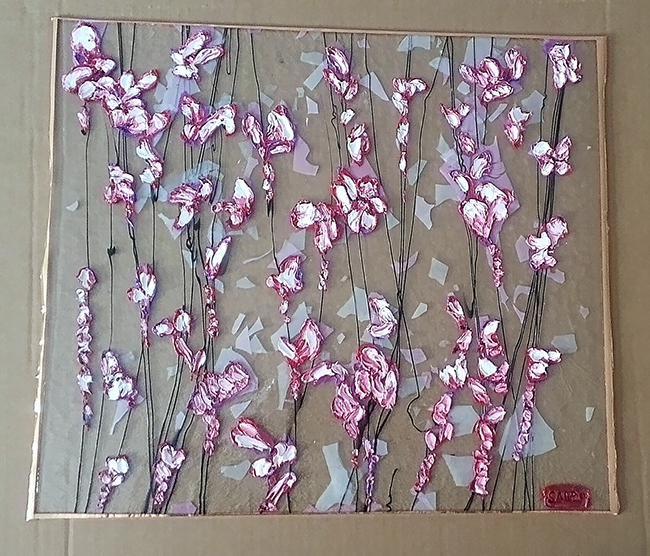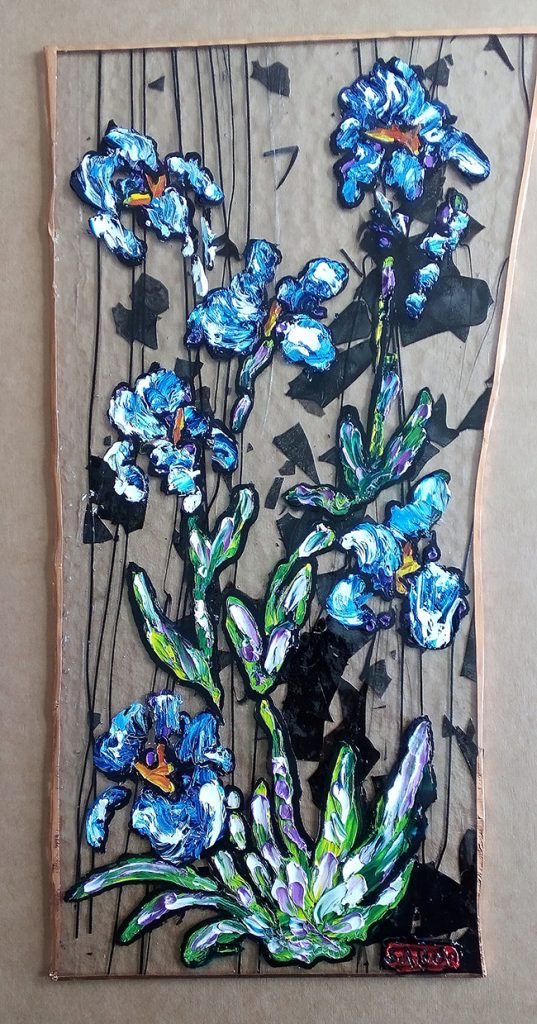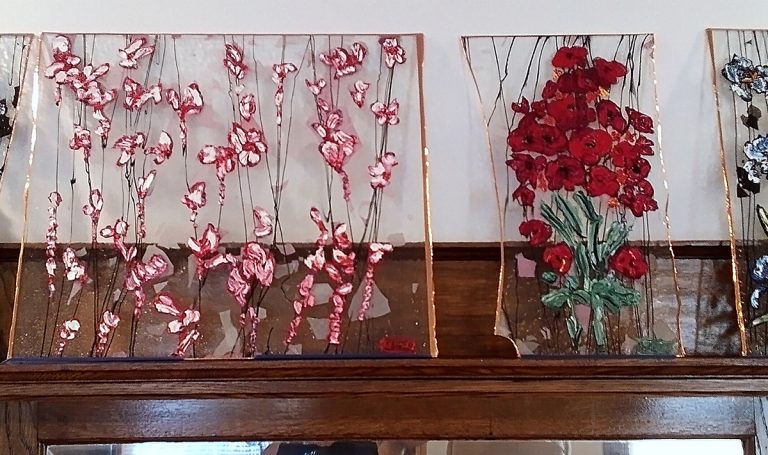Michael Sabin was born and raised in upstate New York, in the same hometown as Tommy Hilfiger. Growing up in the Finger Lakes region, known as Mark Twain Country, he developed an early interest in art. At 23, he started working in Corning, NY, known as the Crystal City, and quickly became captivated by glass—its reflectiveness, versatility, and how it interacts with light. To this day, he continues to work in the glass factories of Corning while pursuing his love of painting. His work focuses on oil and pastel, using both canvas and stained glass panels as his surfaces. This combination of materials allows him to explore the interplay of color, transparency, and depth in a way that few artists do.
A Play of Light

Sabin’s work, A Play of Light, is exactly what it sounds like—a dance between illumination and shadow, color and reflection. He has been painting on stained glass for quite some time, pushing the medium beyond traditional boundaries. Rather than treating glass as just a surface, he incorporates it as an active part of the composition. The results are bold and vibrant, transforming ordinary scenes into something immersive.
At the core of A Play of Light is the way glass manipulates color. Traditional oil paintings rely on pigment and brushwork to create depth, but Sabin takes things further. The glass itself shifts and changes depending on lighting conditions, which means his paintings are never static. They evolve based on their surroundings. Whether sunlight filters through them or artificial light bounces off, the effect is dynamic. This interaction between paint and light is what makes his work stand out.
Sabin has a deep appreciation for color, using it with intention and precision. The brilliance of his palette is heightened by the transparency of the stained glass, which amplifies saturation and contrast. His floral arrangements, a recurring theme in his work, feel almost luminous. The way petals catch the light, the subtle blending of shades, and the layered textures give them a sense of depth that goes beyond the surface. They aren’t just flowers on glass—they feel like they’re suspended within it.

Beyond the visual appeal, there’s also an element of intrigue. Sabin describes his floral compositions as something meant to “tease the mind.” There’s a playful quality in how shapes overlap, how colors shift with different angles, and how light bends through the glass. The work doesn’t reveal everything at once; instead, it invites the viewer to engage with it over time.
Sabin’s process is a mix of structure and spontaneity. Working with oil paint on glass presents unique challenges—unlike canvas, glass is smooth and non-absorbent, meaning the paint behaves differently. Layers need to be built up carefully, and drying times vary. Despite these obstacles, he embraces the medium’s unpredictability. The fluidity of oil paint on glass allows for organic movement, which he balances with careful composition. His arrangements may seem effortless, but they are the result of years of experimentation.
His connection to Corning, NY, plays a significant role in his artistic approach. Being surrounded by glassworkers and immersed in an environment where craftsmanship is valued has shaped his perspective. He understands glass not just as a material but as a language—one that speaks in reflections, refractions, and transparency. This understanding sets his work apart, blending traditional oil painting techniques with the unique properties of stained glass.
While A Play of Light focuses on floral themes, Sabin’s broader body of work continues to explore the relationship between paint and glass. Each piece he creates is an exploration of light—how it moves, how it changes, and how it interacts with color. His art is not just about what is seen, but how it is seen.
For Sabin, the magic lies in the way glass transforms his paintings. What might look like a simple arrangement of flowers at first glance becomes something more as light passes through it. The shifting reflections, the play of color, and the ever-changing nature of his work make it impossible to see the same painting twice. That unpredictability, that movement, is what keeps him coming back to the medium.
Sabin’s work is a testament to the possibilities of blending traditional techniques with unconventional materials. He takes the familiar—oil paint, floral arrangements, stained glass—and reinterprets them in a way that feels fresh and alive. It’s not just about creating something beautiful; it’s about making something that reacts, responds, and plays with its surroundings.
A Play of Light is more than a title—it’s a philosophy. It’s about embracing the way light shapes what we see, about finding beauty in the way things shift and change. And in Sabin’s hands, it’s a reminder that art isn’t just about what’s on the surface. It’s about what happens when light, color, and imagination come together.

